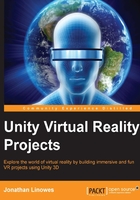
What this book covers
Chapter 1, Virtually Everything for Everyone, is an introduction to the new technologies and opportunities in consumer virtual reality (VR) as regards games and non-gaming applications.
Chapter 2, Objects and Scale, discusses how you can build a simple diorama scene. It introduces the Unity 3D game engine as well as Blender for 3D modeling and explores the issues of world coordinates and scale.
Chapter 3, VR Build and Run, helps you configure your project to run on a VR headset, such as the Oculus Rift and Google Cardboard (Android or iOS). Then, we go into detail about how the VR hardware and software works.
Chapter 4, Gaze-based Control, explores the relationship between the VR camera and objects in the scene, including 3D cursors and gaze-based ray guns. This chapter also introduces Unity scripting in the C# programming language.
Chapter 5, World Space UI, implements many examples of user interface (UI) for VR, which includes a heads-up display (HUD), info-bubbles, and in-game objects with a lot of code and explanations.
Chapter 6, First-person Character, dissects the Unity character objects and components, which are used to build our own first-person character with gaze-based navigation. Then, we'll explore the experience of having a first-person virtual body and consider the issue of motion sickness.
Chapter 7, Physics and the Environment, dives into the Unity physics engine, components, and materials as we learn to work with forces and gravity in a number of VR project examples and games.
Chapter 8, Walk-throughs and Rendering, helps us build a 3D architectural space and implement a virtual walk-through. We also talk about rendering in Unity and performance optimizations.
Chapter 9, Using All 360 Degrees, uses 360-degree media in a variety of projects, including globes, panoramas, and photospheres. We also have a discussion on how it all works.
Chapter 10, Social VR Metaverse, explores the multiplayer implementations with VR using the Unity 5 networking components. We also have a look at VRChat as an example of an extensible platform for social VR.
Chapter 11, What's Next?, in this chapter the author comments about the potential of this exciting technology.